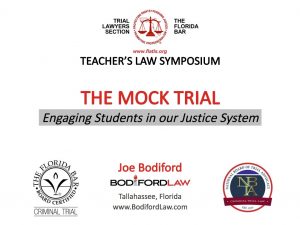Teacher’s Law Symposium Materials
Fair Use Act Disclaimer: This page is for educational and entertainment purposes only. Bodiford Law does not own the contents of all of the PDFs on this page. All credits go to the rightful owners.
“FAIR USE”: Copyright Disclaimer under section 107 of the Copyright At 1976, allowance is made for ‘fair use’ for purposes such as criticism, comment, news reporting, teaching, scholarship, education and research.
Fair use is a use permitted by copyright statute that might otherwise be infringing. Non-profit, educational or personal use tips the balance in favor of fair use.
FAIR USE DEFINITION: (Source: http//en.wikipedia.org/wiki/Fair_use) Fair use is a doctrine in the United States copyright law that allows limited use of copyrighted material without requiring permission from the rights holders, such as for commentary, criticism, news reporting, research, teaching or scholarship. It provides for the legal, non-licensed citation or incorporation of copyrighted material in another author’s work under a four-factor balancing test. The term ‘fair use’ originated int eh Unite States. A similar principle, fair dealing, exists in some other common law jurisdictions. Civil law jurisdictions have other limitations and exceptions to copyright.
U.S. COPYRIGHT OFFICE – FAIR USE DEFINITION (Source: http//www.copyright.gov/fls/fl103.html) One of the rights accorded to the owner of copyright is the right to reproduce or to authorize others to reproduce the work in copies or phonorecords. This right is subject to certain limitations found in sections 107 through 118 of the copyright law (title 17. U.S. Code). One of the more important limitations is the doctrine of ‘fair use”. The doctrine of fair use has developed through a substantial number of court decisions over the years and has been codified in section 107 of the copyright law.

